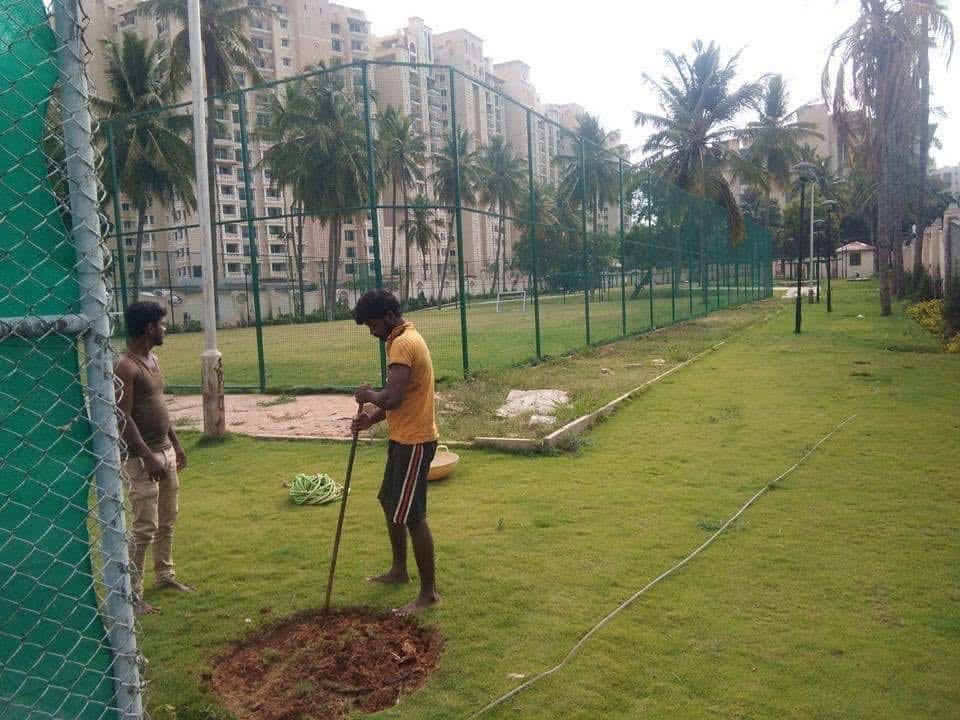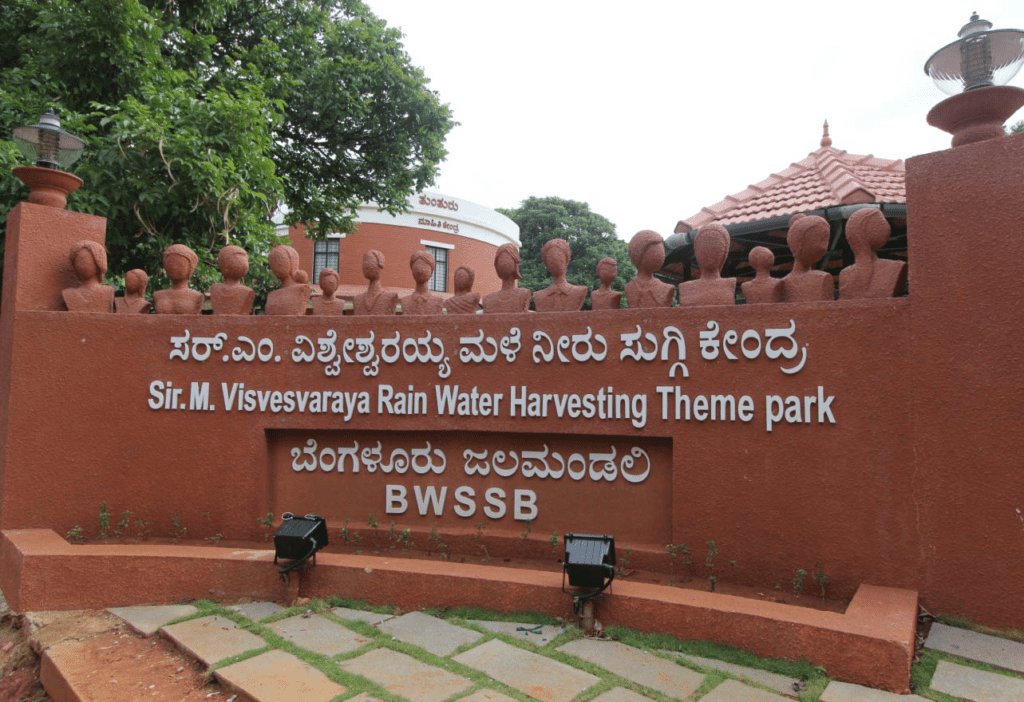When we think of groundwater in Bengaluru, we usually think of borewells. However, a webinar jointly organised by Biome Environmental Trust, BWSSB (Bangalore Water Supply and Sewerage Board) and Citizen Matters showcased many examples of Bengalureans continuing to use open wells for their daily needs.
“Historically, Bengaluru has been dependent on open wells for domestic water,” said Avinash Krishnamurthy of Biome. “So it’s important that we reconnect with open wells, and rebuild our relationship with shallow aquifers that feed open wells.”
One way to do this is by building recharge wells into which rainwater falling on rooftops and other open surfaces can be channelled. “A recharge well can be as small as three feet in diameter and 15-20 feet deep, which can even be retrofitted into the setbacks in our houses/buildings,” said Avinash. “This water can recharge ground water and tomorrow it can become an open well from which we can withdraw water.”
Read more: Towards water security: How to dig a recharge well
Compared to Cauvery water which is drawn from long distances, and borewells which are dug quite deep, open wells are cheaper and leave a smaller carbon footprint. They also help manage floods, and provide livelihoods to the Bhovis, the traditional well-digger community in Karnataka.
Peddanna from the Bhovi community said that in core areas of Bengaluru, water is often available at a depth of just five feet.
Examples aplenty
Individual houses
Raghuram Giridhar, a resident of Vidyaranyapura, explained how his open well provides water security and reduces expenses. “When I started building my house, I wanted to use the groundwater that’s available in plenty around our area,” says Giridhar. “I decided to go for an open well, and was lucky to strike water at around 10-15 feet. It used to replenish itself in about seven hours, and yielded about 2000 litres of water [at a time]. We used it for house construction.”
Raghuram also connected his rainwater sump to the well to recharge it during rains. The well yields water throughout the year now, and Raghuram’s eight-member family uses it for all purposes other than drinking and bathing. His monthly bill for Cauvery water supply comes to only Rs 200. Raghuram encourages others to build a well too, “because having water at your doorstep without depending on anybody is a luxury now a days”.
Another Vidyanranyapura resident Balasubramaniam consumes the bare minimum from his Cauvery water connection. He uses good-quality water from his open well for all purposes including drinking and cooking. Balasubramaniam had dug the well 26 years ago. “After the first six years, the well went totally dry,” recalls Balasubramaniam. “Then I came to know about rainwater harvesting (RWH), and invested a small amount to lay pipelines and filter drums [to channel rainwater into the well].”
Malleswaram resident Dr Meenakshi Bharath in 2002 dug a recharge well right next to her borewell so that the borewell wouldn’t go dry. Tdoay, 20 years later, the borewell yields the same amount of water. “Building a recharge well is simple, it costs only around Rs 25,000,” says Dr Meenakshi. “I have three recharge wells around my house now”.
Apartments
At Adarsh Palm Retreat (APR) apartment in Bellandur, one of the most water-starved areas in Bengaluru, residents turned a water seepage problem into an opportunity. “APR is sitting on a network of shallow aquifers, so we had a basement flooding problem,” said resident Neeru Goyal. “So we dug a withdrawal well which would overflow during rains, and we would pump out the water. But the water was crystal clear, and it felt like a crime throwing it out.”
Neeru did her own research, and the well was made wider and deeper based on her suggestion. Rooftop rainwater was also collected and sent into the well. “This has been in operation for almost three years and we are completely dependent on well water for 5-6 months every year now,” said Neeru. Residents no longer face water scarcity or have to ration water. The water quality, tested twice a year, is found to be much better than Cauvery water, she added.

At Ascot Apartments in Indira Nagar, borewell water was scarce and residents were considering digging another borewell. Residents Ramya Coushik and her husband Sandeep convinced others to build two wells instead. Water from the 3000-sq ft terrace was routed into these wells built in March last year. This January, residents were able to draw 5000-6000 litres of well water every week, said Ramya.
At Classic Orchards, a 71-acre community along Bannerghatta Road, recharge wells built in open areas have helped ward off water scarcity.
Factory premises
At the Rail Wheel Factory in Yelahanka, RWH and revival of open wells has not just reduced costs but also increased the water table in Yelahanka overall. The factory, spread across 191 acres, needs 2-3 lakh litres of water daily. “We had four sources, treated STP water from BWSSB, two open wells, borewells and treated water from our own STP,” said Ajay Singh, Former Chief Workshop Engineer and Chief Environment Officer at the factory
A few years ago, the factory started a project to revive all four of its open wells. They then diverted rainwater from all 191 acres, created wetlands and used these to recharge the four wells. Rooftop RWH was also implemented. “In 2017, we stopped taking water from BWSSB,” said Ajay Singh. “When we faced water scarcity due to low rainfall, we built two more wells. All six wells are yielding good amounts of water now.” The factory has built four other open wells to collect seepage from a tunnel.
“Water from the wells now meets all our requirements. We also have excess water, which we use for groundwater recharge. With this, the water table in Yelahanka area has gone up. Water levels in our three borewells have improved, but we don’t have to use them anymore”.
Parks
As part of Biome’s ‘Million Wells’ campaign, recharge wells have been dug in Cubbon Park in collaboration with the NGO India Cares Foundation and the citizens’ group Friends of Lakes. “Cubbon Park had seven open wells, but they had not been in use for 40-50 years, so we first cleaned and revived those,” said V Ramprasad, Co-founder of Friends of Lakes.
After this, around 75 recharge wells, each 3 ft in diameter and 15-20 feet in depth, were built in parts of the park where water usually collects during rains. India Cares Foundation had to wait nearly two years for permissions from various authorities to dig the wells.
Kusuma G, Deputy Director at the Horticulture Department, who was in charge of Cubbon Park at the time the wells were dug, said the impact was visible in a short time. “Trees became greener because the water table had increased,” said Kusuma. “The wells also helped control flooding. We routed water from the wells to sprinklers, and watered the lawn and bushes.” According to her, the department’s monthly bill for buying tertiary-treated water from BWSSB to water Lalbagh and Cubbon Park has nearly halved now.
Similarly, at the Rest House Park in Ashok Nagar, the real estate company Puravankara Group which maintains the park, has built recharge wells as part of its Corporate Social Responsibility. Here too, water from the recharge wells is used for park maintenance and the dependence on tankers has reduced.

Read more: Two years, one lakh wells: Can ‘Million Wells’ movement help solve Bengaluru’s water crisis?
RWH Theme Park
B M Manjunath, Public Relation Officer at BWSSB, talked about the M Visvesvaraya RWH Theme Park in Jayanagar 5th Block, built by the BWSSB in 2011. The theme park demonstrates 26 models of RWH, and has been guiding visitors on setting them up in their own buildings. “People used to think that RWH was some rocket technology, so we wanted to make them aware that that was not the case,” said Manjunath. “We developed the park by thinking through all the problems people could face in implementing RWH”.

The theme park itself has five recharge wells, all of which have water. “The wells are about 25 ft deep and during rainy season they have 15-18 ft of water which we use for the park’s needs,” said Manjuanath. The park has had a large number of visitors and many had called back for guidance and have installed RWH in their premises. Students from 520 schools and 200 colleges are among those who visited the park.
The park is open between 10 am and 5 pm on working days, and can be contacted at 080 2665 3666.
Q&A session
Following are some questions that came up during the Q&A session, to which Avinash and Uma K from the Biome team responded.
- Can treated water from an apartment’s STP (Sewage Treatment Plant) be routed into its recharge wells?
A: No, the KSPCB (Karnataka State Pollution Control Board) does not allow you to use three types of water for recharging groundwater – STP treated water, RO reject water and swimming pool backwash water.
- Is Biome using technology to map areas where RWH would be more effective, so that groundwater recharging efforts could be focused in those areas specifically?
A: The science and its tools are definitely useful. However, in practical terms, when we deal with a city, if you look at water, solid waste, etc., the problem is really an aggregation of small misbehaviours. The answer lies in trying to make everyone a part of the solution rather than being part of the problem. The important thing is to try and convert the science into simple thumb rules that everybody understands and can implement, while policy and law should treat everybody equally (such as mandating everybody to build recharge structures in any area).
- Since roads and other surfaces in cities generally have large amounts of contaminants, will the aquifer get contaminated if rainwater is recharged deep into the ground?
A: In areas where stormwater drains, roads, etc. likely have industrial contaminants, we need to be very careful and ensure that we don’t use that water to recharge, especially into deeper aquifers, which will contaminate the entire aquifer. But when we talk about urban areas that are largely residential, where we know that the catchments are controlled (such as households, gated layouts, parks, etc), our experience suggests this is not an issue. Whenever people implement RWH, we always communicate about keeping the catchment clean. Also, when using the shallow well rather than deep aquifer for recharge, the earth provides a healthy filtering mechanism.
Those interested in installing RWH can contact Biome at water@biome-solutions.com and also refer to the website bengaluru.urbanwaters.in.
Watch the full event:
Please let us know if the borewell surcharge is applicable for the open well also.
No, it is not.
Nice and good initiative